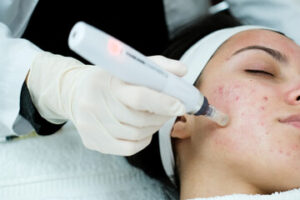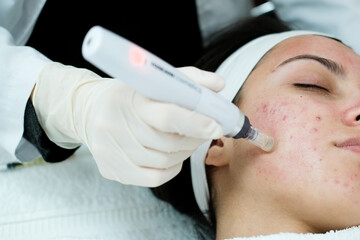Besides reducing wrinkles, Microneedling reduces sun damage (hyperpigmentation), which can give your skin a blotchy, brownish appearance. It also stimulates collagen to fight sagging and tighten skin.
After smoothing on a numbing cream, the doctor or aesthetician moves a pen-shaped device with tiny needles across your face. The pinpricks cause tiny amounts of bleeding that your body recognizes as an injury and reacts to by sending healing collagen.
The goal of microneedling is to stimulate collagen, which fights wrinkles and gives skin a fresh look. Collagen production declines with age and is also impacted by damage caused by acne, sun exposure, or surgery. Microneedling triggers a healing response by creating microscopic injuries to the skin, and the body responds by sending collagen to patch up the tiny wounds. Combined with laser treatment, it can reduce fine lines and wrinkles on the face as well as reduce the appearance of scars and stretch marks.
To get the best results, your dermatologist may recommend a course of microneedling treatments. It can take several months to see results as the skin regenerates and produces more collagen. However, the skin looks radiantly healthy in the meantime.
Before the procedure, you’ll get a numbing cream applied to your face to minimize discomfort from the needle pricks. Then the person performing the treatment will move a pen-shaped or rolling tool with tiny needles over your skin. The needles prick your skin, which causes a little bit of bleeding.
After the procedure, your dermatologist might apply a calming cream or serum on your face. Then you should protect the skin from the sun by using sunscreen with a high SPF factor. You should also avoid exposing the treated area to water or other liquids for 24 hours.
Unlike more traditional cosmetic procedures, such as ablative laser or chemical treatments, microneedling is gentle and has very little downtime. This makes it an attractive option for those with a busy schedule who want to look younger or improve the appearance of their skin.
While there are many products available to perform microneedling at home, your dermatologist will use professional equipment that is hygienically cleaned and sterilized to minimize the risk of infection. Moreover, the needles on DIY (do-it-yourself) devices are much shorter, so they don’t work as well to stimulate collagen, Pierre says. It’s also not a good choice for those with deep boxcar or pitted scars, which are better treated by surgical methods. However, you might be able to see some improvement with a dermaroller if you have shallower scars or only mild discoloration.
Reduces Acne
Microneedling is an effective acne treatment that helps reduce the appearance of scars from previous breakouts. It works by stimulating the skin to produce collagen and elastin, which reduces fine lines and wrinkles, and improves the overall tone and texture of your complexion. It also works to reduce inflammation caused by active acne blemishes, so it helps to minimize the redness and discoloration that are often associated with acne.
During the process, tiny needles are used to puncture your skin. This creates small wounds, which trigger your body to naturally produce collagen and elastin to heal the skin. As a result, this can dramatically reduce the appearance of pockmarks and reduce the severity of your acne scarring.
In one study, researchers found that 73% of patients with grade 4 acne scarring saw their scars improve by two grades after four microneedling sessions. In addition, patients with grade 3 acne scars had their scarring reduced by one grade. The authors conclude that this is due to the skin repairing itself following the microscopic injuries.
Because this is a medical procedure, it’s important to consult with a board-certified dermatologist before you decide to get a microneedling treatment. Your dermatologist will perform a full evaluation of your skin to make sure it’s safe for you to undergo the treatment. They will ask you a few questions to understand your skin, and determine how many treatments you need to see the best results.
The most common side effects from a microneedling treatment are minor skin irritation and redness. You may notice some bruising and swelling in extreme cases, but these effects are usually short-lived. It’s important to apply a calming moisturizer or cream to your skin after the treatment. You should also avoid UV rays after the treatment, as your skin will be more sensitive.
Microneedling is a great option for people with acne and acne scars who want to look younger. If you are interested in learning more about this innovative treatment, contact us today to book a consultation at Caci. We’ll help you get clear and gorgeous skin!
Reduces Stretch Marks
Stretch marks are caused by a tearing of the skin due to rapid weight change, pregnancy, bodybuilding, and hormone replacement therapy. They can appear anywhere on the body and are difficult to cover up with regular skincare products. The good news is that microneedling can help reduce the appearance of your stretch marks. Microneedling stimulates your skin’s natural collagen production, which helps reduce the appearance of stretch marks.
During the procedure, the micro-needles will prick the surface of your skin to create what are called “micro-injuries.” These tiny wounds trigger your body’s healing response and signal that it is time to ramp up collagen production in the area. Over the course of a few months, the new collagen will gradually fill in your stretch marks and make them less noticeable.
In fact, several studies have shown that microneedling can increase collagen in the skin and decrease the appearance of stretch marks and other scars. This is why it is also known as collagen induction therapy.
The results from microneedling will vary from person to person. However, most people will need a series of treatments to see an improvement in their stretch marks. The number of treatment sessions will be determined by your expert during your consultation.
After a microneedling session, it is important to use a collagen-boosting serum, such as hyaluronic acid or retinol. These serums can be applied after dermarolling and will work better when used on fresh stretch marks.
Unlike some other skincare treatments, microneedling doesn’t involve chemicals or lasers, so it is safe for all skin types and colors. It is also non-invasive and doesn’t require any downtime, making it an ideal choice for busy individuals.
If you’re looking for a way to reduce the appearance of your stretch marks, call our Pittsburgh office and schedule a microneedling appointment today! We’ll use a medical-grade automated microneedling device to create controlled micro-injuries on your skin and promote collagen production. You’ll love the results! The best part? They’ll keep getting better and better over time! Contact us today to book your appointment!
Reduces Scars
If you have pock marks or scarring from acne, microneedling may be able to help. According to research conducted by BUSM, the process of creating tiny injuries on your skin with needles actually decreases the appearance of scars. The microtrauma stimulates the formation of tons of new collagen, which helps smooth out your skin, reduce wrinkles and heal photodamage. The resulting younger and refreshed skin will make you look more radiant as well as improve the quality of your life!
The process of microneedling can be used alone or in combination with other treatments like chemical peels, laser resurfacing and platelet-rich plasma (PRP) for maximum results. Combinations of these techniques can help you achieve even more dramatic improvements, especially for deeper scars and other conditions such as melasma or hyperpigmentation. Microneedling also improves vascular lesions, such as broken blood vessels.
Unlike other treatments for reducing scars, which can be harsh and cause excessive down time, microneedling is safe and effective. It can be used on all skin types and to treat many different conditions. Microneedling can also be combined with radiofrequency treatment for deep penetration and enhanced results. Insulated needles are used to penetrate the skin while releasing radiofrequency energy on the dermal structures and accessory glands without damaging the overlying epidermis. The resulting thermal zones are responsible for long term dermal remodelling and neoelastogenesis.
Before your appointment, you will be asked to avoid sun exposure and drink plenty of water to reduce the chances of bruising or inflammation. After the procedure, you may experience some redness and dryness for a few days. You can use a lightweight powder to hide the effects if needed, but most people can return to their daily activities right away.
You will notice an improvement in your skin tone and texture after the first few sessions, but it will take a few months for the results to become more noticeable. Your dermatologist will recommend a maintenance regimen to help you maintain your results. A serum containing hyaluronic acid, vitamin E, epidermal growth factors and antioxidants can be applied to your skin after your microneedling treatment. This can provide further hydration and support the skin healing and renewal process.

